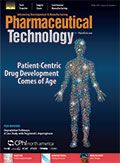Particles on Best Behavior
Characterizing particles and understanding bulk powder behavior is critical to get the best pharma product.
DROBOT DEAN - STOCK.ADOBE.COM

It is well known that particle characterization is an important consideration when ensuring optimal product development and efficient manufacturing within the pharma industry. Variance in particle properties can create handling challenges, and if manufacturers do not correctly characterize a powder and do not have a good understanding of powder behavior, the ultimate outcome will more than likely be a poor-quality product.
Jamie Clayton, operations director at Freeman Technology, spoke to Pharmaceutical Technology about the criticality of particle characterization, particularly when considering bulk powder behavior, some important considerations for developers, and technologies available and in the pipeline.
Crucial for pharma development
PharmTech: How important is particle characterization in pharmaceutical development?
Clayton (Freeman Technology): Particle characterization is crucial for the pharma industry because of well-established relationships between parameters such as particle size and shape and characteristics that define clinical efficacy-for example, the dissolution profile of a solid dosage form. However, it’s important to understand how physical properties affect powder behavior in general, and the importance of bulk powder characterization as an equally vital and complementary tool.
Bulk powder properties such as flowability, compressibility, bulk density, and permeability often define or impact aspects of pharmaceutical product performance and processing behavior. For instance, flow properties influence the time taken to blend APIs and excipients to homogeneity, and the ease and uniformity of die filling, which in a tableting process can directly impact the quality of the finished product.
Where bulk powder properties are influential, measurement is essential as they cannot be predicted from a knowledge of particle properties. In fact, powders are actually three-phase assemblies consisting of solid particles, gas, and a certain level of liquid, typically water. Behavior is governed by the interactions between the three phases. Measuring a combination of particle and bulk powder properties is usually the best approach to supporting and optimizing pharmaceutical development and manufacture.
More efficient manufacturing
PharmTech: How can particle and bulk powder characterization help enhance manufacturing efficiencies?
Clayton (Freeman Technology): Particle characterization can help drug developers to detect process relevant problems, such as attrition or contamination, but characterizing bulk powder properties is arguably more informative when it comes to enhancing manufacturing efficiency as it can quantify a range of behavioral properties that directly influence in-process performance. These include powder flow properties under process-relevant conditions, the response of the powder to fluidization and consolidation, and the impact of issues such as moisture uptake or caking.
Wet granulation provides a good illustration of how such data can be used to enhance manufacturing efficiency. Tableting blends are often subject to wet granulation to produce a homogeneous, relatively free-flowing feed that compacts well in the press. However, it can be difficult to define an effective specification for the granules-a process endpoint-as they are an intermediate rather than a finished product.
Research has shown that the flow properties of granules correlate directly with tablet quality, specifically hardness, which is a typical critical quality attribute (1). It is therefore possible to control a wet granulation process to a successful outcome, through the manipulation of processing parameters, on the basis of a flowability specification. Granules meeting this specification will go on to produce tablets of the required quality. This approach is far more efficient and responsive than working up batches of granules into tablets to determine their quality and significantly more relevant than inferring flowability from particle size measurements, which in isolation, may not reliably differentiate poorly performing materials.
Similarly, studies have shown that bulk powder properties can reliably inform on performance in a range of unit operations including vial filling, blending, die/capsule filling, and compaction (2–4).
Technologies: Present and future
PharmTech: What technologies are currently available for bulk powder characterization?
Clayton (Freeman Technology): United States Pharmacopeia (USP) <1174> lists a number of methods for powder flow testing including angle of repose, flow through an orifice, Compressibility Index and Hausner Ratio (both of which are based on measurements of tapped density), and shear cell methods (5). With the exception of shear cell, these largely manual, traditional methods tend to suffer from poor repeatability and reproducibility, and they provide relatively limited insight into process and product performance.
Dynamic powder testing is a more innovative technique developed specifically to meet growing industrial demands for a comprehensive understanding of bulk powder behavior. Performed using a powder rheometer, dynamic testing quantifies the energy associated with moving a powder under different stress and flow regimes. Powders can be analyzed in a consolidated, moderately stressed, aerated, or fluidized state to simulate the condition in the process of interest. Data are highly repeatable and reproducible, and the technique is sensitive making it particularly valuable for process and product-related studies.
PharmTech: Are there any promising technologies in the pipeline that you believe will create a paradigm shift in the characterization of particles and powders in pharma?
Clayton (Freeman Technology): For particle and powder properties that are routinely measured to support development and manufacture, there is a natural inclination towards real-time, in-line measurement. In-line technology eliminates any requirement for sampling, automatically measuring in situ under the most representative conditions and evaluating a much higher proportion of the process stream-all of which are crucial gains when working with powders. By providing more representative and relevant data, faster than at-line and off-line techniques, in-line technology has the potential to transform the ability to control and optimize pharmaceutical processes.
In-line technology is well-advanced in some areas but in others it is just emerging. For powder characterization, an important advance is the introduction of in-line drag force flow (DFF) technology. This provides continuous, real-time measurement of the local forces associated with the movement of powders or granules within a process. A DFF sensor is a fine needle-like structure that can be inserted directly into process equipment. The data generated have been shown to correlate with established off-line techniques, demonstrating the potential to transfer process and product-relevant specifications from the lab into the manufacturing line.
Dosage form nuances
PharmTech: Are there particular particle and bulk powder characteristics that developers should be mindful of when considering different dosage forms?
Clayton (Freeman Technology): The example of dry powder inhalers (DPIs) is useful in illustrating how developers need to be aware of the properties that impact both product performance and manufacturing efficiency for any given dosage form. Dosator technology is used routinely to produce packaged, uniform, low doses for DPIs. Filling of a dosator tube requires a relatively free-flowing powder but with a certain level of cohesion so that compression forms a secure plug that remains in the tube and transfers securely to the packaging.
In a study investigating the relationship between dosator performance and bulk flow properties, aeration behavior was found to be important (a measure of cohesion), but so too was the impact of interparticular friction and mechanical interlocking, which heavily influence the ability of a powder to flow under gravity (6). Such studies highlight the conflicting demands of the production process relative to those for optimal dose delivery. As drug delivery requirements are likely to be a priority, insights into processing performance provide valuable guidance on specifying equipment and optimizing process conditions.
In terms of tableting, experience suggests that dynamic flow properties, compressibility, and permeability are all important characteristics for tablet blends. Dynamic flow properties impact blending performance and die filling, with more free-flowing formulations associated with more uniform dispersion and efficient filling. Permeability influences hopper discharge behavior as well as the release of air from the die during filling.
Compressibility is critical in determining response to compaction in the press. The effect of flow additives and lubricants can be assessed through dynamic testing-to determine the impact on flow properties-with shear methods additionally useful for evaluating likely interactions with processing equipment, including the tablet press, and hopper performance.
Characterization challenges
PharmTech: What are the main challenges that developers experience with particle and bulk powder characterization currently?
Clayton (Freeman Technology): From the perspective of powder testing, there are a number of challenges worth highlighting. Firstly, the methods in USP <1174> (5)-with the possible exception of shear cell methods-are not necessarily wellâsuited to the current requirements of the pharmaceutical industry. These techniques offer simplicity but provide minimal information on which to base product or process development.
Shear cell methods are useful for hopper design and more broadly for investigating a powder’s ability to transition from a static state under moderate to high stress. While modern shear testers now deliver good reproducibility, the technique is not always suitable for understanding the performance of powders in the low stress/aerated state that prevails in many pharmaceutical operations. Shear cell testing is also perceived by many as a relatively complex, expert task, and outsourcing remains commonplace.
Dynamic testing provides the most insightful data for product and process optimization, and the instrumentation used typically also allows shear and bulk powder property measurement, delivering comprehensive, multi-faceted powder characterization that supports an optimal approach in product development and powder processing. The challenge is of course justifying the initial investment associated with such instrumentation, though experience demonstrates that the payback is highly beneficial.
PharmTech: Are efforts being made to address these challenges?
Clayton (Freeman Technology): A recent advance that directly addresses issues associated with shear cell testing is the commercialization of uniaxial testing. Uniaxial testing ranks powder flowability via the same metric as shear cell testing but employs a simpler, more direct technique. Testing is fast, intuitive, and highly repeatable/reproducible, and equipment costs are low. Uniaxial testing can therefore offer a good solution for those needing a simple, modern, easy-to-use technique that delivers robust, high quality data.
With respect to investing in more powerful powder characterization technology, the tangible benefits of having access to better data have become much clearer over recent years. It is now far easier to understand how powder testing will support development, manufacturing, and troubleshooting with recent insights from industry leaders highlighting the potential for economic gain.
References
1. T. Freeman, “In Pursuit of Wet Granulation Optimization,” Pharmaceutical Manufacturing, (Mar. 21, 2014).
2. E.M Littringer, et al., “Filling of Powders for Dry Powder Inhalation Using a Vacuum Drum Filler,” Poster presented at AAPS (San Diego, CA, Nov. 2–6 2014).
3. J. Clayton, Org. Process Res. Dev. 19 (1) 102–109 (2015).
4. Freeman Technology, “The influence of roller compactor process parameters on granule properties,” Application Note.
5. USP, USP General Chapter <1174> “Powder Flow” (US Pharmacopeial Convention, Rockville, MD, 2012).
6. J. Clayton, et al., OnDrugDelivery 85 (4) 16–20 (2018).
Article Details
Pharmaceutical Technology
Vol. 43, No. 4
April 2019
Pages: 50–52
Citation
When referring to this article, please cite it as F. Thomas, “Particles on Best Behavior,” Pharmaceutical Technology 43 (4) 2019.

Drug Solutions Podcast: A Closer Look at mRNA in Oncology and Vaccines
April 30th 2024In this episode fo the Drug Solutions Podcast, etherna’s vice-president of Technology and Innovation, Stefaan De Koker, discusses the merits and challenges of using mRNA as the foundation for therapeutics in oncology as well as for vaccines.
Entering New Domains for 3D Printing of Drug Products
April 6th 20253D printing of personalized medications is currently possible under existing compounding regulations, offering enhanced process control through automation. But new legislation coming in 2025 will allow 3D printing as part of a distributed manufacturing framework.